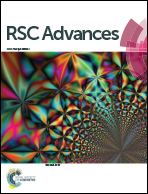Polarization enhanced multi-grain-boundary dendritic micro–nano structure α-Fe for electromagnetic absorption applications: synthesis and characterization†
Abstract
In this paper, multi-grain-boundary hierarchical dendritic micro–nano structure α-Fe was successfully synthesized in electrolyte containing rare earth (RE) ions by the electric field-induced and electrochemical reduction method. The results show that the size of the dendritic morphology samples decreases from about 10 μm to about 6 μm with increasing RE ion concentration, and plentiful nano-sized particles are generated on their surface due to the adsorption suppression effect of the RE ions, which facilitates a great increase in the BET surface area and the formation of abundant grain boundaries. All of these RE-added dendritic α-Fe exhibit excellently enhanced electromagnetic absorption performance. The minimum reflection loss (RL) value (around −60 dB) of the RE-added samples is twice that of the samples without added RE ions, and the absorption peak moves to higher frequency range as the RE ion concentration is increased. The widest absorption band (in which RL < −20 dB) of the La-added samples grows to 2 GHz. We mainly ascribe the great enhancement of the EMA performance to the unique structural characteristics, such as the great surface area and abundant grain boundaries, which could affect the dielectric loss and magnetic loss of the absorbers. Not only has this work directly confirmed the influence of the interface and grain boundaries on the electromagnetic absorption performance, but it has also provided a new way to control the morphology and microstructure using RE ions.


 Please wait while we load your content...
Please wait while we load your content...